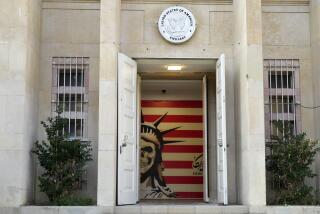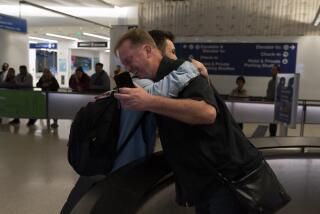The second revolution
MARK BOWDENâS âGuests of the Ayatollahâ begins on the morning of Nov. 4, 1979, when a small rabble of Iranian students gathered outside the U.S. Embassy in Tehran and prepared to take on the worldâs mightiest superpower with nothing more than nunchucks, broken boards and something that âlooked like a croquet mallet.â Within minutes, U.S. Marine guards (who were ordered not to shoot by embassy personnel) had surrendered, and by midafternoon, the Iranians controlled the embassy, capturing 66 people, including American diplomats, military attaches and the CIA station chief.
Although the students were followers of the Ayatollah Ruhollah Khomeini, their tactics were modeled after antiwar protests at American universities. The plan was simple: to stage a sit-in at the embassy and âissue a series of communiques that would explain Iranâs grievances against America,â chief among them President Carterâs decision to allow the recently deposed shah to enter the U.S. for medical treatment. But as one student organizer later told Bowden, âWe lost control of events very quickly.â So began what Americans came to know as the âhostage crisis,â a 444-day televised humiliation that led to the meltdown of the Carter presidency, the collapse of traditional Cold War alliances in the Middle East and the rise of Iran as a militant Islamic theocracy.
A national correspondent for the Atlantic Monthly, Bowden has made a career of writing about Americaâs confrontations with Third World villains; his books âBlack Hawk Down: A Story of Modern Warâ and âKilling Pablo: The Hunt for the Worldâs Greatest Outlawâ pop with cinematic intensity. Both focus on members of the U.S. armed forces on missions in failed nation-state badlands. They have the feel of contemporary westerns. The guys in the white hats are invariably the Americans.
Telling the story of the U.S. Embassy personnel taken hostage and the failed military mission to rescue them places Bowden in familiar terrain. But âGuests of the Ayatollahâ aspires to something more. Bowden aims to investigate the complexities of what he labels âThe First Battle in Americaâs War With Militant Islam.â Of the many questions he promises to explore, most pertinent are those he asks in the opening chapter: âWho were the Iranian protesters?â and âWhat were their motives?â
Yet after an initial teaser, in which we meet an Iranian preparing himself for martyrdom prior to the embassy attack, Bowden switches gears. The focus turns to the American protagonists, and here it stays for the next 600-plus pages. We cheer the urbane, chain-smoking embassy official who unexpectedly resists his captors, standing up to repeated beatings to show that his spirit wonât be broken. We witness CIA officers forced to choose between torture and revealing names that will result in the deaths of their contacts. At times, Bowden relieves the tension with grim humor, as when Marines taunt their captors by using the ayatollahâs name to describe bodily functions; âI need to take a Khomeini,â they say.
As in his earlier books, Bowden has a penchant for the dramatic tableau, although he seldom cites sources for the many scenes he re-creates. Of the mob outside the embassy, he writes: âThe enraged masses roared like some mindless, insatiable, million-throated monster, screaming for American blood. It was as though an impregnable fort had been breached and taken. It was a great victory, a cleansing, an exorcism.â
The situation at the embassy is intercut with detailed accounts of the Carter administrationâs efforts to free the hostages, of the failed Delta Force mission to raid the embassy and of the election-year politics that saw the nation swing to the right and elect Ronald Reagan president. Bowden also recounts parallel maneuverings in Iran. Yet while Iranians populate the story, their viewpoints are largely absent. Instead, Bowden renders them as they appeared to the Americans, in a word (employed by Carter in a note to his chief of staff): âcrazy.â
From the standpoint of the hostages, the Iranians were by turns terrifying, despicable and clownish. Although beatings were rare, hostages were constantly threatened, sometimes bound for days and subjected to at least one mock execution. One hostage taker, dubbed âGap Tooth,â couched his tirades against the âGreat Satanâ in leftist, anti-imperialist claptrap picked up during his student days at UC Berkeley. Others lectured captives on their own moral superiority while stealing their belongings and even, Bowden reports, cheating at checkers. Toward the end of the ordeal, an Iranian jailer wasnât too proud to ask for a favor: â[D]o you think I could get a visa?â He hoped to go to school in America.
Not all Iranians are portrayed as maniacs. Bowden describes a guard who smuggles letters out for the hostages, as well as others who later question some of their actions. Still, one senses that he isnât all that interested in the Iranians, enamored as he is of the guys in the white hats. Although American readers will surely root for American heroes, this is a serious flaw in a book about a war of culture and religion. Bowden neglects to do what military strategists call âturning the mapâ-- entering the mind of your enemy and viewing your position through his eyes in order to better defeat him.
Bowden tells us next to nothing about the students, other than to quote the propaganda they spouted. He does a better job outlining sources of Iranian rage, notably the 1953 British-and-American-sponsored coup that removed Iranâs popular, democratically elected prime minister (who made the mistake of nationalizing the oil industry) and handed power to the shah, who had been a figurehead since the early days of World War II. As Bowden explains, by the time of the Islamic Revolution, the CIA âhad more or less ceded all intelligence work inside the country to SAVAKâ -- the shahâs hated secret police -- and American policy had made the shahâs army and air force essentially a U.S. military adjunct. Itâs no wonder, then, that to many Iranians, the American presence in their country was, to say the least, suspect.
The day of the embassy takeover, Iranâs revolution was nearly 10 months old. Khomeini, exiled in 1964, had been readmitted to the country but denied a political role. The nation was ruled by a provisional government, which hoped to restore ties with the United States. Representatives had recently met with Carter administration officials to resume shipments of American weapons and restart secret U.S. listening posts inside Iran to track Soviet missiles. This rapprochement fell apart when the shah entered the U.S. for cancer treatment. Iranians feared it was a prelude to his reinstatement.
The hostage takers became heroes in Iran for daring to do what the government wouldnât -- stick it to the Americans. Thus shamed, the provisional government collapsed. Khomeini declared that the students had triggered âa second revolution, more glorious than the first.â He became the ruler of Iran, and a militant theocracy was born. Emboldened by the ruptured Iranian-American alliance and fearing the spread of Islamic fundamentalism, the Soviets invaded Afghanistan. At the same time, Saddam Hussein, a Soviet client, attacked Iran. In short order, the U.S. secretly allied itself with Hussein. The Cold War standoff that had dominated the Middle East fell apart.
Today, as American troops battle purported Iranian-backed militias in Iraq and Iranâs president (a former student militant identified by some as a participant in the takeover) threatens to go nuclear, there is no need for Bowden to remind us of how high the stakes have become. A scene near the end of the book reveals the toll already taken on America. In it, an Iranian perversely offers a soon-to-be-released American captive the chance to torture him. The American declines, saying, âWe donât do stuff like that.â Thereâs an irony here, but Bowden overlooks it and the complicated history it suggests.
âGuests of the Ayatollahâ is a page-turner, but the shame is that we never get to know those students who stormed the embassy in the bookâs stunning opening moments. Such knowledge is required if we expect to win the conflict the Pentagon now calls the âLong War.â
More to Read
Sign up for Essential California
The most important California stories and recommendations in your inbox every morning.
You may occasionally receive promotional content from the Los Angeles Times.










